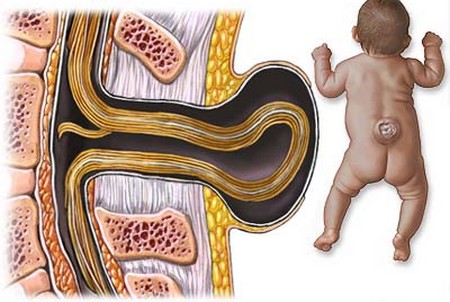This condition is caused by a spinal column defect in which one or more of the bones forming the backbone (the vertebrae) fail to join properly, leaving a gap or a split; spina bifida is one of the most common congenital abnormalities in children. More boys than girls are affected.
The condition varies in severity. At one end of the scale, spina bifida occulta is very mild, and usually goes unnoticed. The visible sign may be a dimple in the back, but most people with this are unaware they have an abnormality because they don’t experience any symptoms at all. At the other end of the scale, spina bifida cystica is more serious. The visible sign is a cyst (or sac), almost like a large blister, on the back. It is covered with a thin layer of skin.
There are two types of spina bifida cystica:
- Meningocele. This type occurs when the cyst contains some of the meninges (membranes that cover the spinal cord) and the spinal fluid that surrounds the brain and spinal cord. In most instances, damage to the nerves is limited, and so a child with meningocele is only mildly affected.
- Myelomeningocele. This type occurs when the cyst contains the meninges, the spinal fluid, and also part of the spinal cord, which is therefore damaged. Myelomeningocele is a more-serious form of spina bifida. It always involves some degree of paralysis. Most children with this condition have difficulty with bladder and bowel control, and may never be entirely continent.
In addition, a baby born with spina bifida usually has hydrocephalus (brain fluid cannot drain into his bloodstream). The effects of hydrocephalus vary, but often include visual and learning difficulties, seizures, and coordination problems. The precise cause of spina bifida is not known, although it is thought to be genetic. The nervous system is one of the first parts of the body to develop, and the neural tube—from which the brain and spinal cord develop—is formed within the first twenty-five days of pregnancy. Spina bifida arises when the neural tube grows abnormally.
Evidence does suggest, though, that spina bifida is at least partly inherited. A woman who has already had one child with spina bifida has an increased chance of having another with the same problem. The chance of an adult with spina bifida having a child with spina bifida is one in twenty. Genetic counselling is available, and tests can also be done to determine whether the fetus is affected.
A large-scale survey found that in more than one-third of families with a child who had myelomeningocele, the mother admitted that she had been counselled against having any more children, and about 25 percent stated that having a child with spina bifida had made them very anxious about the possibility of subsequent pregnancies. However, nearly 20 percent of the mothers felt that having a child with spina bifida had not influenced the size of their family; they either intended to have more children, or had decided before the birth of the affected child that they would not have any more. A small number of mothers reported that having a child with spina bifida made them decide to have a larger family than they had originally planned—perhaps to prove to themselves that they could have a nonaffected child.
Most children with spina bifida are able to attend their local school. Segregated special schooling is recommended only when a child’s learning difficulties are so severely impaired, or when his physical difficulties are so extreme, that his needs cannot be met within an ordinary classroom.
Categories
Advertisements
Recent Articles
 How to Understand Bed Sizes – A Small Guide
How to Understand Bed Sizes – A Small Guide How to Select Some Must Have Kitchen Accessories
How to Select Some Must Have Kitchen Accessories Best Way to Change a Car Tire
Best Way to Change a Car Tire Best Way to Write an Affirmation
Best Way to Write an Affirmation Best Way to Take Charge of Your Financial Life
Best Way to Take Charge of Your Financial Life Best Way to Survive a Party When You Don’t Know Anyone
Best Way to Survive a Party When You Don’t Know Anyone Best Way to Stop Self Sabotaging Yourself
Best Way to Stop Self Sabotaging Yourself Best Way to Start Journal Writing
Best Way to Start Journal Writing Best Way to Speak with a Powerful Voice
Best Way to Speak with a Powerful Voice Best Way to Simplify Your Life
Best Way to Simplify Your Life Best Way to Respond to a Put-Down
Best Way to Respond to a Put-Down Best Way to Reduce Acne Breakouts
Best Way to Reduce Acne Breakouts Best Way to Recover from Dining Disasters
Best Way to Recover from Dining Disasters Best Way to Quit Your Job Gracefully
Best Way to Quit Your Job Gracefully Best Way to Make Your Own Website
Best Way to Make Your Own Website



Leave a Reply